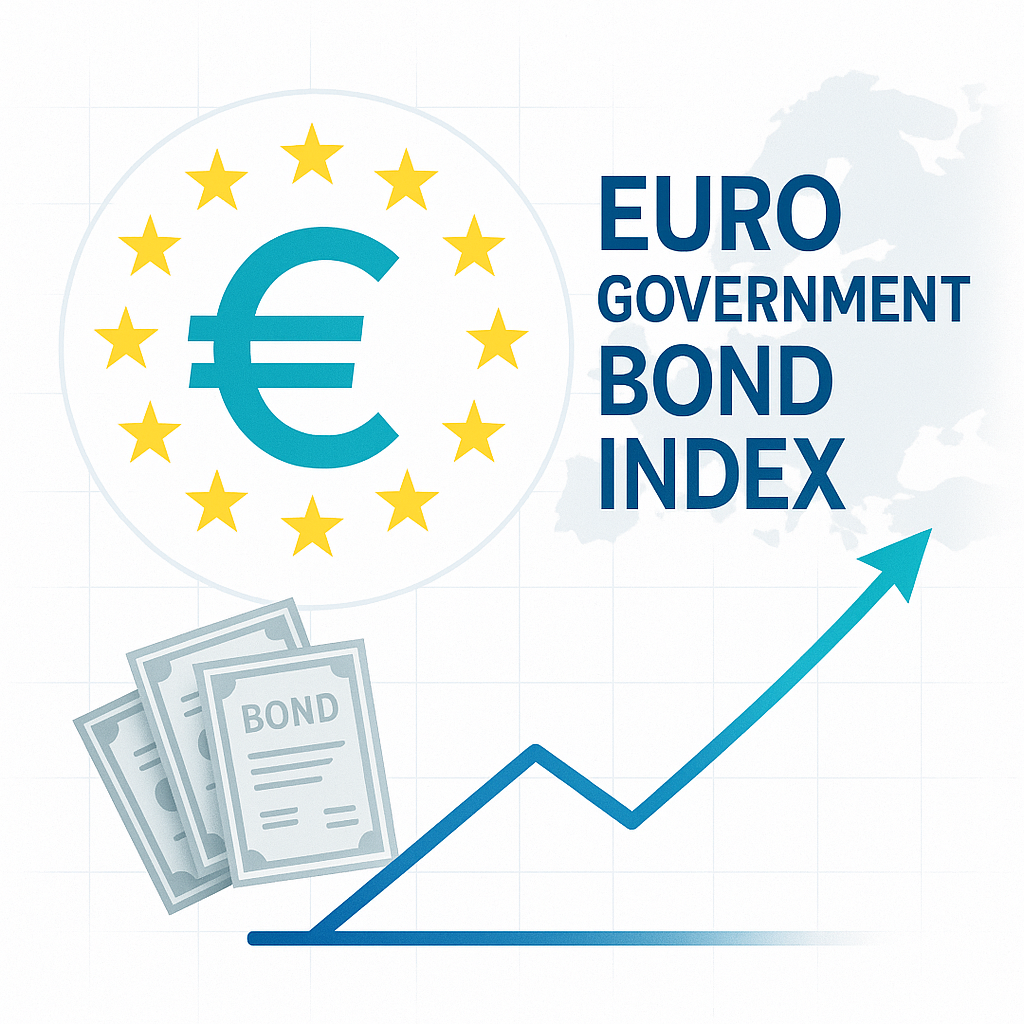Euro Government Bond Index is a composite benchmark that tracks fixed-rate, investment-grade sovereign bonds issued in euros by members of the euro area—thereby providing investors with a single gauge of risk-free duration and yield across the entire monetary union.

1. Why It Exists
The euro-area sovereign market now tops more than €8 trillion. Consequently, a broad Euro Government Bond Index distils that vast universe into a daily, market-value-weighted performance yard-stick. Accordingly, portfolio managers benchmark core bond funds to it, while central banks reference the index when sizing euro-reserve duration.
2. Inclusion Rules at a Glance
| Filter | Requirement | Transition Note |
|---|---|---|
| Issuer | Central governments of euro-area member states | First and foremost, focuses on sovereign risk-free names |
| Currency | Euro-denominated only | Likewise, removes FX noise |
| Credit Quality | Investment-grade (BBB-/Baa3 or higher) | Thus, screens out high-yield volatility |
| Minimum Issue Size | ≥ €250 million outstanding | In turn, ensures tradability |
| Maturity at Entry | ≥ 1 year; bond exits when < 1 year remains | Hence, keeps duration meaningful |
| Coupon Types | Fixed-rate and inflation-linked OAT€iS / BTP€i; excludes floaters & bills | Meanwhile, maintains rate exposure purity |
Subsequently, the index rebalances monthly, adding new auctions after settlement month-end.
3. April 2025 Snapshot
- Market Value: ≈ €8.3 trillion
- Number of Issues: 672
- Duration: 7.1 years
- Yield-to-Worst: 2.32 %
- Top Issuers by Weight: Germany 23 %, France 21 %, Italy 18 %, Spain 13 %, Netherlands 6 %
- Inflation-Linked Share: 4.5 %
Therefore, the index balances core German depth with higher-yield peripherals.
4. Recent Performance
| Year | Total Return (EUR) | Comment | Transition Note |
|---|---|---|---|
| 2022 | –16.4 % | ECB liftoff shocked long rates | Initially, policy reversal hurt duration |
| 2023 | +6.0 % | Inflation cooled; duration recovery | Subsequently, bonds rebounded |
| 2024 | +5.1 % | Carry and modest spread compression | Moreover, peripherals outperformed |
| YTD-2025 | +1.3 % | Range-bound Bund yields, tighter peripherals | So far, steady gains persist |
Peripheral-core spread (10-yr BTP–Bund) presently sits near 125 bp, the tightest since early 2022.
5. How Investors Use It
- Benchmarking. Core euro fixed-income funds gauge excess return versus this neutral basket; thereafter, performance fees align with true alpha.
- Asset Allocation. Global multi-asset CIOs map euro duration and, additionally, risk contributions.
- Policy Analysis. Economists track curve shifts in order to infer growth and ECB expectations.
- Passive Exposure. ETFs such as IEGA or EUNA replicate the index, thereby offering low-cost access.
6. Key Drivers of Yield & Spread
- ECB Policy Path. Deposit rate at 3.75 %; markets therefore price two 25 bp cuts by March 2026.
- Fiscal Dynamics. EU fiscal rules restart in 2025, consequently capping deficits and net supply.
- Inflation Outlook. Eurozone HICP expected at 2.4 % in 2025, thereby guiding real yields.
- QT & PSPP Roll-Off. ECB balance-sheet runoff removes a steady buyer, thus nudging term premia higher.
7. Strengths & Limitations
| Strengths | Limitations |
|---|---|
| To begin with, comprehensive euro-sovereign coverage. | Conversely, excludes Treasuries of non-euro EU states (e.g., Poland). |
| Moreover, market-value weights reflect investible size. | However, hefty German weight skews duration lower than peripherals. |
| Finally, a long history back to euro launch (1999) aids stress testing. | Meanwhile, no credit-spread capture beyond sovereign level. |
8. Looking Ahead
Net sovereign issuance is projected to fall 10 % in 2026 as pandemic financing winds down, potentially flattening euro curves. Furthermore, an accelerated green-bond pipeline from France and Spain could, in turn, push the index’s ESG-labelled share above 12 % within two years.
Key Takeaways
- Euro Government Bond Index bundles investment-grade sovereign debt from all euro-area members.
- April 2025 metrics: €8.3 T market value, 7.1-year duration, 2.3 % yield.
- Ultimately, ECB policy, fiscal supply, and peripheral spreads steer returns, making the benchmark essential for euro-denominated portfolios.